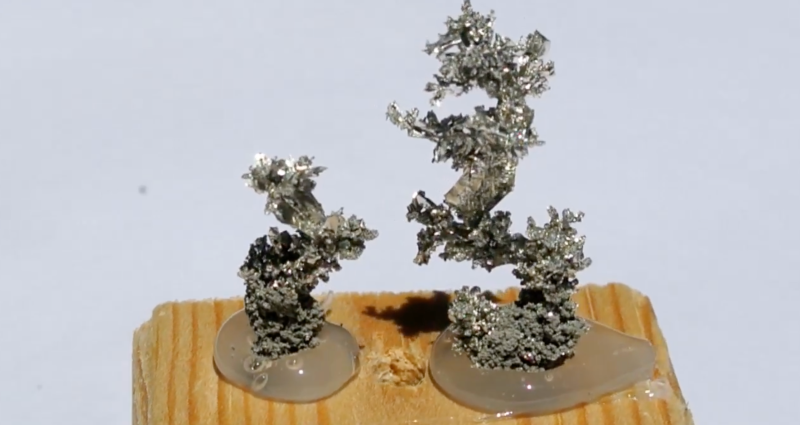[The Plutonium Bunny] saw homegrown tin crystals on YouTube and reckoned he could do better—those crystals were flimsy and couldn’t stand up outside of the solution in which they were grown. Having previously tackled copper crystals, he applied the same procedure to tin.
Beginning with a 140 ml baby food jar filled with a solution of tin II chloride, 90 grams per liter, with a small amount of HCl as the electrolyte. A wire at the bottom of the jar was connected to a blob of tin and served as the anode, while the cathode, a loop of tin, stuck down from above. A LM317-based adjustable voltage regulator circuit was used to manage the power running through the solution. Because [The Plutonium Bunny]’s technique involves days or even weeks of very low current, he used six diodes to drop the circuit’s voltage from 1.5 V to 0.25 V, giving him around 13 mA.
His first attempt seemed to go well and he got some nice shiny crystal faces, but he couldn’t get the current bellow 10 mA without it dropping to the point where no tin was depositing. Rather than reset the experiment he made some changes to the project: he changed the solution by removing 30 ml of the electrolyte and topping it off with water. He also made a gentle agitator out of a DC motor and flattened plastic tube from a pen, powering it with another low-voltage LM317 circuit so he could get the lowest RPM possible.
With this new setup [The Plutonium Bunny] began to get much better results, proving his hypothesis that low current with a lower concentration of Sn2+ was the ticket for large crystal growth. We featured his copper crystal experiments last year and he’s clearly making good progress! Video after the break.
















How do 6 diodes in series give him a total voltage drop of 1V? Also, if you’re using a LM317 anyway, why no use it as a current regulator, if you are interested in a constant current? In constant current mode, the minimum voltage of 1.25V drops across the current sense resistor, so you wouldn’t need those diodes either.
Germanium diodes maybe.
Schottkys.
Schottkys Vf should be around 0.4V at 20mA, meaning six would be a 2.4V drop.
Voltage drop in a diode isn´t fixed. It has a “maximum” that keeps almost constant over a certain current until it fries, but if you use very little current the voltage drop will be much smaller than the expected.
I never liked Schottkys sandwiches, Just not the same as Jersey Mikes.
Tchotchke diodes look better,
Tchaikovsky diodes sound better.
The chemistry is going to limit the current if you keep lowering voltage. Half-cell potentials and all that. The reactions at the electrodes have energy barriers. The basic rule for electrolytes, or conduction by ions: Lower concentration = higher resistance. I think the current will drop to zero when the voltage gets down to the potential for one of the half-reactions.
Sparky, I’m also thinking that a current limited supply is likely a better way to go. Or run the voltage through a resistor in line with the electrochemical cell. The reaction for depositing the tin crystals probably has a minimum bandgap voltage to proceed forward, and a current limited supply is better for getting really close to that limit.
How about growing bismuth crystals?
Well now I gotta buy some Pepto…
Does palladium crystallize?
Every element can be crystallized…crystallization is highly ordered microscopic structure, forming a crystal lattice that extends in all directions…if you can atomize and restructure (on a nano-scale), then you have crystallization. There are multiple ways to achieve it as well; arc vapor, electrolysis, plasmonics…in the future nano-bots could do it…etc.
The question I think you wanted to ask is; “Does Palladium crystallize via electrolysis”…the answer is; not at low voltage/low amperage….at least not in any acceptable time frame (many, many years). Platinum and Palladium are used in fuel cells and electrolysis for Hydrogen because they do not break down much at all (fuel cell poisoning however, is a separate, related issue). If you performed high voltage electrolysis in a high saturation electrolyte, then you can get small crystals formed from local plasma reactions…however, while technically crystals, they are not pure, and only cool to look at under a microscope.
Metals are rarely found in their pure state because of the characteristic of metals (free/excess electrons in the valance shell)…these free electrons usually bind with the most readily available element lacking electrons in it’s valance shell (oxygen)…we find 90% of metals as an oxidized “ore”…we then drive off the oxygen with heat in a furnace. Heat provides half of the requirement to crystallize; meaning it purifies the metal and most importantly; it has the atoms mobile…however, heat alone creates random chaos (hysteresis)…so, what does this have to do with crystals? Well, lets imagine iron; if we take our pure iron, heat it to a degree of atom mobility, then cool it suddenly you “harden” it…ie, “flame-hardening”, temper, etc. This is crystallizing, in varying degrees…
Natural crystals usually occur in void geodes…void geodes were bubbles of vaporized or, gaseous atoms (HIGHLY mobile), the outer silica cools and encrusts the bubble…then gravity adds order to the chaos as the gas cools and crystals grow….
So, every element can crystallize, you just have figure out how…
Thanks,
As, bismuth has a low melting point, I was wondering if palladium worked the same way….